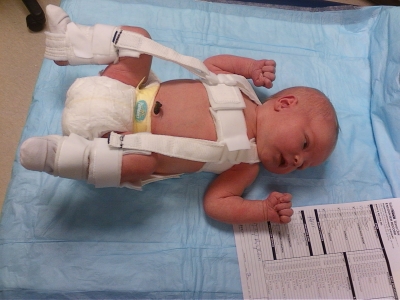Developmental Dysplasia of the Hip (DDH) is an abnormal development of the hip joint. It occurs when the femoral head dislocates from the acetabulum, or in easier terms, when the hip dislocates from its socket.
DDH is usually diagnosed in newborns and can happen in utero, during delivery or after birth. It is most common in girls, first borns and with twins. It is quite serious if it goes unnoticed. It is important to have your baby checked for any dysplasia, as early detection is key for a full and uncomplicated recovery.
Approximately 1 in 600 girls will have DDH, while only 1 in 3000 boys will suffer from the condition and it tends to occur more in babies with disorders such as spina bifida, cerebral palsy and clubfoot deformities.
Normally the femoral head (the top of the thigh bone) sits in the acetabulum (the hip socket) and is made stable by surrounding ligaments. But with DDH there is a laxity in the ligamentous tissues around the joint and the femoral head can dislocate in a superior and lateral direction.
While hip dysplasia is more commonly found only in one hip, it is not uncommon for it to present bilaterally. Therefore early diagnosis and treatment is essential to achieve the best outcomes and avoid future complications.
Causes
• Joint laxity
• Ligamentous laxity – pregnant mothers secrete a hormone called relaxin intentionally causing ligamentous laxity in preparation for the delivery through the pelvis, but this hormone can be passed into the babies bloodstream causing laxity within their ligaments, hence loosening the hip joint
• Breech babies – due to the prolonged pelvic flexion experienced in utero or due to the pressures put on the hips during a breech delivery
• Family history – around one third of babies with DDH have a blood relative with the condition
• Twins – due to the lack of space in the uterus and hence increased pressure on the pelvis during gestation.
Signs and Symptoms
• Stiff hip joint(s)
• Different leg lengths
• Uneven gluteal folds of the bottom
• One knee looks higher then the other when bent
• A clunking sound when the hip is rotated
How to check
Diagnoses can be made after birth with a physical examination. This usually involves visual inspection looking for any of the signs and symptoms mentioned above. Orthopaedic tests will be done by your doctor, nurse or chiropractor who will place the baby on their back and rotate each leg at the hip to check for range of motion and any feel for any clunks which may indicate DDH.
If DDH is suspected, an ultrasound will be performed on babies up to the age of 6months while Xray can be done after 6months of age.
Treatment
Treatment for DDH involves using Pavlik Harness’, the Dennis Browne Bar or a hip Spica’s, which will hold the hip in flexion and abduction, allowing the femoral head to sit in the acetabulum while proper development of the bones and ligaments occurs. Most babies will require the harness for between 6 and 12 weeks and don’t appear to be distressed by its use.
Chiropractic co-management is appropriate in cases of DDH as the biomechanical dysfunction caused by the hip will have a direct affect on pelvic and spinal alignment. Emphasis should be placed on treatment after the removal of any harness used in treatment. Chiropractic treatment can help restore proper movement and biomechanics of the spine pelvis and sacrum after a prolonged period of no movement.
In terms of prognosis, the earlier the dysplasia is found and treated will almost always ensure normal development of the hip. In patients where treatment begins after the 1st year of life about 50% can expect to be trouble free with the other half having high chance of re-dislocation or early onset of secondary arthritis.
If you want to have your baby assessed for developmental hip dysplasia or if you have any questions related to your child’s development through their milestones please contact the clinic and we will be more then happy to help.
If you would like more information or would like to book an appointment at Neurohealth Chiropractic – please call the clinic on 9905 9099 or email us admin@neurohealthchiro.com.au or fill in the contact form from our website www.neurohealthchiro.com.au
Sign up to receive Neurohealth Chiropractic’s Free monthly health newsletter on the Right Hand Side of this page. Filled with great information and lots of easy health tips to keep you at Optimal Health!




